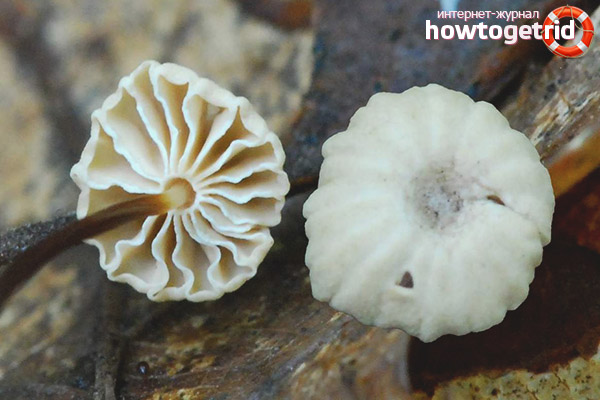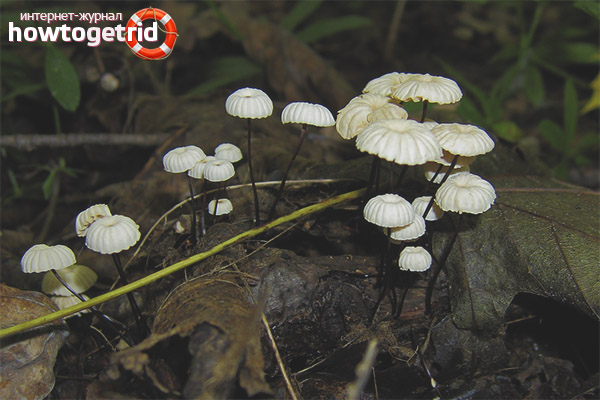The content of the article
Wheel-shaped negniuchnik - an inedible species of fungi belonging to the family of non-oleic fungi. The Latin name for this species is Marasmius rotula.
Description
The hat of representatives of this type of mushroom is rather modest in size and reaches only 10 -15 mm in diameter. At the beginning of development, the shape of this part of the fungus is spherical, straightens with growth and becomes more prostrate. In the central part of the cap, you can notice a characteristic, albeit narrow, but rather deep cavity. The surface of the cap itself has a fibrous structure, which allows you to clearly see all its details (tubercles, depressions). At the first glance at the mushroom, it may seem that the hat of the negutil has absolutely no pulp, however, the latter is very thin and practically visually inseparable from the lamellar body. The hat of specimens at the beginning of growth is very light, with the growth of the fungus acquires a gray-yellow color. The aroma of the pulp, although weak, is quite sharp.
White plates are located with small gaps, most often grow to a characteristic collar that borders the mushroom leg. Spore powder has the same color as the plate-like body.
The negniuchnik has a rather thin leg, the length of which reaches 80 mm. This part of the fungus is dark in color, almost black at the base.
Species distribution
Similarity with other species
Often this type of inedible mushroom is confused with the neglar Bullar, which has almost the same appearance (white color of the fruiting body, and a characteristic wheel shape). Nevertheless, the main difference between the wheel-shaped negus is the presence of a pronounced collar located in the upper part of the leg, to which the plates descending from the plate body are attached.
Edibility

According to available information, the wheel-shaped non-sniper does not belong to poisonous species of fungi, however, it is also not used in cooking, which is due to its very modest size.
View Features
The main feature of this type of mushroom is that in dry periods, non-snacks almost completely dry out, however, this does not mean their complete death. With the beginning of the rainy season, representatives of this species are fully restored to their previous form, and they again begin to bear fruit and grow.
I would like to draw attention to the fact that this type of mushroom, in fact, does not have practical significance. The only thing that scientists stand out is an enzyme such as MroAPO contained in this fungus, which is a kind of biosensor used for the analysis of aromatic substances.
Other negros
The Marasmius mushroom family includes about 500 diverse species, and only a small fraction of them are edible. The remaining species, as a rule, are not collected, often the reason for this is the unattractive appearance of the mushrooms and their modest size.
Such a species as a tenderloin is the most delicate - it is a modest-sized fungus that does not have any nutritional value. At the beginning of development, specimens of this species have a hemispherical hat, which straightens with the growth of the fungus. In adult mushrooms in the center of the hat there is a small tubercle of a characteristic dark-brick color. The body of the cap is rather thin, the edge is wavy with rare radial folds. At the beginning of development, the hat has a white color, with the growth of mushrooms it darkens. Leg, like a hat, rich brown. The peak of fruiting of this species of neglectors is from mid-summer to mid-autumn. Most often, these fungi are found in mixed forests.










Submit